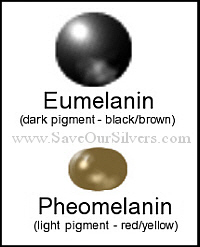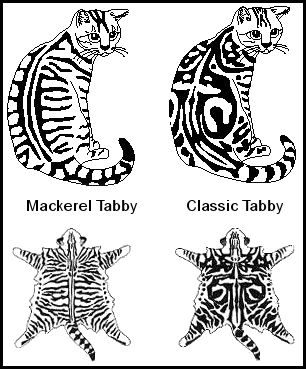

The Quest for Green-eyed Silver Tabbies
The journey from copper, to hazel, to green

The CFA Show Standard: "SILVER TABBY (classic, mackerel): ground color pale, clear silver. Markings dense black. Undercoat white. Lips and chin the same shade as the rings around the eyes. Nose leather: brick red. Paw pads: black. Eye color: green, hazel, or brilliant copper."
The Basic Genetics of Feline Eye Color
Terms
Melanin: a complex polymer that originates from the amino acid tyrosine.
Melanocyte: a cell in the hair, skin and eyes that produces and contains the pigment called melanin.
Melanosomes: intracellular structures that are uniquely generated by pigment cells that function to synthesize and store melanin pigments.
| What we refer to as eye color is from a combination of factors: |
| * the types of melanins produced |
| * the color of the iris |
| * and the light scattering properties that create the depth of color |
One of the most remarkable features of cats is the variation of eye color. The normal range is wide, ranging from copper, gold, and hazel, through shades of green and blue-green. The variability of eye color is due to polygenes that tend to over-ride the effect of the major genes for eye color. Littermates can inherit different mixes of these genes which allows for them to have different eye colors. They can also have different mixes of polygenes causing various shades of color.
The influence of polygenes means that, within reason, selective breeding can stabilize any eye color as desired. In practice, it is easier to 'fix' extreme shades (such as copper or green) than intermediate ones. An exception to this is the blue eye color of the Siamese and various white breeds which is associated with major genes. can stabilize any eye color as desired. In practice, it is easier to 'fix' extreme shades (such as copper or green) than intermediate ones. An exception to this is the blue eye color of the Siamese and various white breeds which is associated with major genes.
The two major pigments produced in all melanocytes are eumelanin (black/brown) and pheomelanin (red/yellow). The intensity or depth of iris color depends on the number of melanocytes in the eye. The difference in iris color is determined by the number of melanocytes present and the variation of the melanosome structure and composition within the melanocytes. Darker irides have larger melanin granules and greater granule density. The production levels of melanocytes is genetically determined so it is possible to selectively breed for either deeper or paler eye colors.
The Basic Genetics of Silver Tabby Coat Color
|

|
Genotypes
| A |
Agouti - ground color of tabby |
I |
Inhibitor - suppresses pigment |
| aa |
Non-agouti |
ii |
Full pigmentation |
| B |
Black pigment |
T |
Mackerel - Striped tabby |
| C |
Maximum pigmentation |
tb |
Classic - blotched tabby |
| D |
Dense pigmentation |
Wb |
Wide band |
| Black Smoke |
aa-B-D-I |
| Shaded Silver |
A-B-D-I-Wb |
| Shaded Golden |
A-B-D-ii-Wb |
| Silver Mackerel Tabby |
A-B-C-D-I-T |
| Silver Classic Tabby |
A-B-C-D-I-tbtb |
| Brown Mackerel Tabby |
A-B-C-D-ii-T |
| Brown Classic Tabby |
A-B-C-D-ii-tbtb |
| Solid Black |
aa-B-C-D |
|
The agouti gene (A)
The agouti gene (A) determines the distribution of pigment in the hair. In eumelanistcally pigmented black hair shafts (B), the agouti band is normally a drab grayish yellow/orange color with a brindled appearance that is caused by a band of yellow on the otherwise dark hair shaft. The agouti band in eumelanistic (black-based) colors, marks the period where the production of melanin has slowed down. The granules in the hair shaft have been "shredded" which gives them a yellow to orange color as they reflect light in various shades of brown. In the non-agouti solid black cat, the yellow band is absent, so there is solid dark pigment throughout the hair shaft. All cats have a tabby pattern - even if they are non-agouti, they still carry a tabby pattern which can be masked by other genes.
Black Pigment (B)
Melanin is a color protein granule that is deposited in the hair shaft which, due to the modifiers present, can vary in size and arrangement; this gives variations in color and pattern. Melanin comes in two forms: dark, round black/brown color granules (B) (eumelanin), and light, elongated red/yellow color granules (O) (pheomelanin). Although there are both types of color granules in the hair shaft, they are in varying levels. A solid black cat, has an abundance of eumelanin granules but only trace amounts of pheomelanin. Several modifying genes can cause variation in the density of the melanin granules, so other colors can be produced; the most variation is found in the black-based (eumelanistic) colors. Black granules are distributed in various ways to produce brownish colors that range from gold and cinnamon to chocolate, which are all variations of black. Cats called "brown tabby" are genetically black tabby.
Full Color Gene (C)
Full color expression.
Dense Pigmentation (D)
The dominate dense pigmentation gene (D) allows for the complete expression of pigment.
The Inhibitor Gene (I)
The inhibitor gene (I) causes the hair's color  granules to migrate to the end of the hair shaft leaving the base void of color (i.e. translucent, appearing to be white). The amount of translucence in the hair shaft depends on other genes (ie: agouti and wide band) working in tandem with the inhibitor gene. The inhibitor gene is better at blocking black-based pigment than red-based pigment so at times, a break-though of the pheomelanin (yellow/red) occurs and this suggests that perhaps while the inhibitor gene is dominant, there is a limit to the amount of pheomelanin it can suppress. The result is a small amount of pheomelanin pigment showing in isolated areas resulting in an undesirable color break in the otherwise translucent hair shaft called tarnish. granules to migrate to the end of the hair shaft leaving the base void of color (i.e. translucent, appearing to be white). The amount of translucence in the hair shaft depends on other genes (ie: agouti and wide band) working in tandem with the inhibitor gene. The inhibitor gene is better at blocking black-based pigment than red-based pigment so at times, a break-though of the pheomelanin (yellow/red) occurs and this suggests that perhaps while the inhibitor gene is dominant, there is a limit to the amount of pheomelanin it can suppress. The result is a small amount of pheomelanin pigment showing in isolated areas resulting in an undesirable color break in the otherwise translucent hair shaft called tarnish.
Tabby Gene (T or tb)
The gene responsible for the mackerel tabby is (T) with narrow, vertical stripes on the body and face. One of the mutant recessive alleles that has arisen from the tabby gene is the blotched or Classic Tabby (tb) pattern which has a shoulder pattern that looks like a butterfly, while each side of the cat should have a solid blotch encircled by one or more unbroken rings.
Wide-band Gene (Wb)
The wide-band gene is theoretical but widely accepted. At this time, how the agouti, inhibitor and wide-band genes interact together is not clear. One possibility is that the wide-band gene allows for a high production of agouti protein so that eumelanin pigment is inhibited. Another possibility is that the wide-band gene encodes for a second inhibitory protein that also reduces eumelanin.
Resources:
The Book of the Cat - edited by Michael Wright and Sally Walters, copyright 1980
https://www.vgl.ucdavis.edu/services/coatcolorcat.php
http://ib.berkeley.edu/courses/ib162/Week3a.htm
http://felinegenetics.missouri.edu/feline-research-projects/silver-and-golden
http://www.fanciers.com/other-faqs/color-genetics.html
http://www.rainbowsafaribengals.com/genetics101.php
https://aminoapps.com/c/warriors/page/blog/epidemiology-eye-pigmentation/Zagz_ewcBulBl7Yg8g73egW0vdlR7dNRE
https://www.reviewofophthalmology.com/article/the-colors-of-ocular-health
https://onlinelibrary.wiley.com/doi/10.1111/j.1751-1097.2008.00316.x
https://www.gccfcats.org/wp-content/uploads/2021/09/BasicCatgenetics.January2022.pdf
https://thelittlecarnivore.com/en/blog/cat-coat-tabby-patterns-genetics
Content and images by Jayne Wood, Alchemist Persians
The information and images in this article are property of the author and this website. If you use any of the content or images on this page on another website or social media, you must give reference to this site and the author.
|
|
|